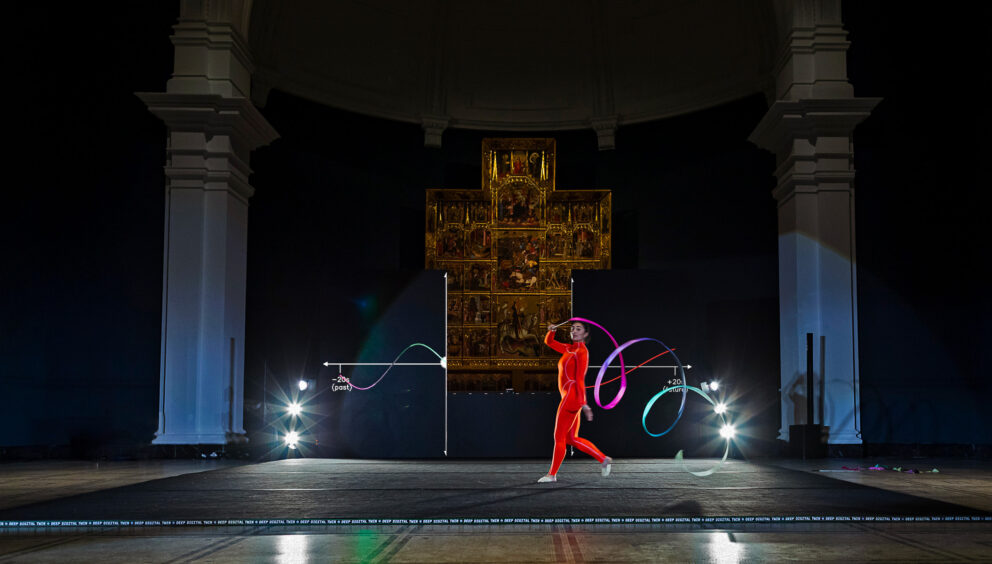Legrand Jäger:
ribbon.Py, fate spinning, curve fitting
Studio maakleerplek
Periode: 01.02—15.05.2022
[ENG]
Eva Jäger and Guillemette Legrand (Legrand Jäger) research emerging applications of computation/information technologies (i.e. emotional recognition, movement recognition, natural language processing, etc.) using performance, film and tech-integrated objects and installations as a way of diagramming the belief systems they create.
[NL]
Legrand Jäger is een samenwerking tussen Eva Jäger en Guillemette Legrand, een kunstenaars duo met als uitganspunt het belang van voorspellingsmodellen als bron van kennis en het effect ervan op onze imaginaire toekomst.
Deze residentie maakt deel uit van het bovenlokaal project ‘EXPAND(ed)’ wordt ondersteund door de Vlaamse Overheid.
This residency is part of the project ‘EXPAND(ed) and is supported by the Flemish Government.
Website
 ribbon.Py: fate spinning, curve fitting, 2021. Image created by Legrand Jäger, includes photograph of Hannah McKibbin pictured at Athens Olympics, 2004 by Robert Laberge.
ribbon.Py: fate spinning, curve fitting, 2021. Image created by Legrand Jäger, includes photograph of Hannah McKibbin pictured at Athens Olympics, 2004 by Robert Laberge.
 ribbon.Py: fate spinning, curve fitting by Legrand Jäger with Isaac Clarke, Victoria and Albert Museum, London, 2021. Gymnast pictured, Mimi-Isabella Cesar. Image courtesy of Hydar Dewachi.
ribbon.Py: fate spinning, curve fitting by Legrand Jäger with Isaac Clarke, Victoria and Albert Museum, London, 2021. Gymnast pictured, Mimi-Isabella Cesar. Image courtesy of Hydar Dewachi.
 ribbon.Py: fate spinning, curve fitting by Legrand Jäger with Isaac Clarke, Victoria and Albert Museum, London, 2021. Gymnast pictured, Mimi-Isabella Cesar. Image courtesy of Hydar Dewachi.
ribbon.Py: fate spinning, curve fitting by Legrand Jäger with Isaac Clarke, Victoria and Albert Museum, London, 2021. Gymnast pictured, Mimi-Isabella Cesar. Image courtesy of Hydar Dewachi.
 ribbon.Py: fate spinning, curve fitting by Legrand Jäger with Isaac Clarke, Victoria and Albert Museum, London, 2021. Gymnast pictured, Mimi-Isabella Cesar. Image courtesy of Hydar Dewachi.
ribbon.Py: fate spinning, curve fitting by Legrand Jäger with Isaac Clarke, Victoria and Albert Museum, London, 2021. Gymnast pictured, Mimi-Isabella Cesar. Image courtesy of Hydar Dewachi.
Legrand Jäger:
ribbon.Py, fate spinning, curve fitting
[ENG]
RESIDENCY
For their residency at Cas-co, the art & design duo Legrand Jäger (Guillemette Legrand and Eva Jäger) will continue their ongoing research and performance project ribbon.Py, fate spinning, curve fitting– – this time, developing the live performance into cinematic form as a short film. The project’s general aim is to question the coercive nature of the specific language of data modeling as they develop ways to ‘gaze back at algorithmic prediction.’ For the last year, they have been using gymnastics, specifically the curves found in ribbon dancing as an embodiment of a statistical modeling and as a means to produce data to train a predictive model. Together with developer Isaac Clark, they have designed a computational programme capable of analyzing the movements of a ribbon dancer and the curves they produce with their apparatus. The performance becomes a way of generating data and diagramming the logic behind models used to forecast so much about our lives, from the COVID-19 pandemic to climate change.
RIBBON.PY
Last year Legrand Jäger created a day-long immersive performance at the Victoria and Albert museum in London. In this performance, rhythmic gymnast Mimi-Isabella Cesar executes a choreographed routine with their ribbon apparatus. This is processed by various computer vision algorithms including MoveNet and multi-dimensional data visualisation tools such as UMAP. The shape, colour and motion of the dancer and their ribbon is registered as data points, training a programme made for this performance, ribbon.Py, to identify patterns with confidence and thereby make assumptions about the choreography and the ribbon’s curve. An Encoder-Decoder LSTM (long short term memory) model uses these patterns to extrapolate possible choreographic sequences.
[NL]
RESIDENTIE
Voor hun residentie bij Cas-co zal het kunst- en designduo Legrand Jäger (Guillemette Legrand en Eva Jäger) hun lopende project ribbon.Py, fate spinning, curve fitting voortzetten. Ze zullen de bestaande performance omzetten naar een cinematografische vorm, de kortfilm. Dit project trekt de dwingende aard en taal van datamodellering in twijfel en zoekt naar manieren om algoritmische voorspellingen naar nieuwe vormen te vertalen. Samen met ontwikkelaar Isaac Clark heeft Legrand Jäger een computerprogramma ontworpen dat de bewegingen van een lintdanser en de curves van het lint kan vastleggen. De dansperformance wordt een manier om gegevens te genereren en de logica achter modellen die worden gebruikt om zoveel over ons leven te voorspellen — van de COVID-19-pandemie tot klimaatverandering — in kaart te brengen.
RIBBON.PY
Vorig jaar creëerde Legrand Jäger een ‘one day performance’ in het Victoria and Albert Museum in Londen. In deze voorstelling voert turnster Mimi-Isabella Cesar een gechoreografeerde routine uit met het lint. Dit wordt verwerkt door verschillende computer vision-algoritmen, waaronder MoveNet en multidimensionale gegevensvisualisatietools zoals UMAP. De vorm, kleur en beweging van de danseres en hun lint worden geregistreerd als data, waarmee een voor deze voorstelling gemaakt programma, ribbon.Py, wordt getraind om met vertrouwen patronen te identificeren en daardoor aannames kan doen over de choreografie en de curve van het lint. Een Encoder-Decoder LSTM-model (Long Short Term Memory) gebruikt deze patronen om mogelijke choreografische sequenties te extrapoleren.

